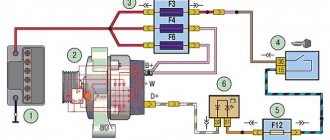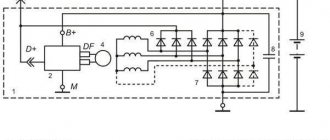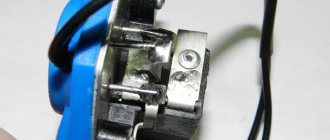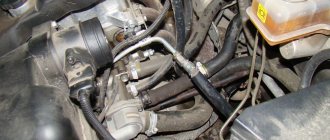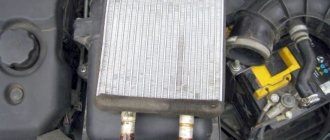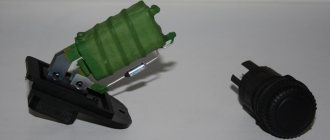Generator connection diagram for Lada Priora VAZ-2170, 2171 and 2172
Lada Priora VAZ-2170, 2171 and 2172 are equipped with a generator 5102.3771 with the following characteristics:
- Maximum output current at 14 V = 80A
- Adjustable voltage, Volts = 13.8–14.4
- Power density = 205 W
- Generator weight = 5.4 kg.
The figure above shows a wiring diagram for the generator on the Priora , here is its explanation:
1 – battery;
3 – main fuse block;
4 – ignition switch;
5 – mounting block;
6 – battery fault warning light
The voltage to excite the generator when the ignition is turned on is supplied to the “D+” terminal of the regulator through the battery warning lamp No. 6 in the instrument cluster. After starting the engine, the excitation winding is powered by three additional diodes installed on the generator rectifier block. The “W” output of the generator is not used on Lada Priora cars. The operation of the generator is monitored using the battery warning light located in the instrument cluster. When the ignition is turned on, the lamp should be on, and after the engine starts, it should go out. If the lamp does not go out after starting the engine, you need to take a multimeter in your hands and check the presence of voltage supply to the on-board network from the generator.
Source
Checking with a tester
The easiest way to check the generator voltage regulator with a multimeter on the Priora is to measure the voltage on the battery.
To do this, you need to perform the following sequence of actions:
- set the multimeter to measure DC voltage with a limit of at least 20 V;
- start the engine;
- at idle speed (1000-1500 rpm) the tester should show 13.2-14 V;
- when the number of revolutions increases to 2000-2500, the voltage should increase to 14.2 V;
- at maximum speed the tester should show no more than 14.5 V.
If the voltage differs greatly from the specified one, drops below 13.5 V or rises above 14.5 V, we can conclude that the unit is faulty.
We assemble a simple circuit: connect the light bulb to the brushes, the negative terminal of the power source to the ground terminal, the positive terminal to terminal “B” of the regulator. When 12.7 V is supplied, the light should light. When raised to 14-14.5 V, the control should go out. If the light goes out earlier or does not go out at all, the control device is faulty.
Which generator is better to install?
Regardless of which generator is installed on the Priora, the owners of these cars often replace the unit due to the fact that not all devices allow connecting various equipment to the on-board network. Which manufacturer is good and which device is better to install on the Lada Priora?
You can supply generators of the following brands:
- BATE 90 ampere;
- KZATE 115a;
- BOSCH 120 amp;
- devices manufactured by VAZ for 120 or 115a.
Generator unit for Priora
In principle, other models of generator devices for domestic cars can be found on sale. When purchasing, the main thing is to check the integrity of the unit so that there are no signs of damage on the body. It is better to use high power so that there is a power reserve, thereby the device will last longer. In addition, it should be taken into account that it is not recommended to install less powerful generators, especially if many devices are connected to the vehicle’s on-board network.
Operating modes of the VAZ 2110 regulator
Since the device has a three-level circuit, there should be three gradations:
- The minimum voltage that the regulator supports is 13.6 V, this applies to
- difficult operating conditions at high air temperatures;
- normal mode stabilizes the voltage at 14.3 V;
- the maximum is a voltage of at least 14.7 V for operation under load conditions at low air temperatures.
Installing a three-level relay is quick and hassle-free and is no more difficult than replacing the brushes. The instructions that come with the device explain in detail each step, including switching. The price of a three-level regulator for a VAZ 2110 is no more than 350 rubles, depending on the manufacturer.
Thus, after weighing the pros and cons of the device, you can significantly extend the life of the battery and stabilize the operation of electrical equipment in the car for little money. Good luck to everyone and stable voltage in the network!
Air conditioning systems
One of the consumers is a heating device. It is part of the climate control system. A control controller works with this system. The work is automatic. The driver only sets certain parameters.
On cars, the electrical circuit of a VAZ Priora may contain air conditioning systems. After pressing the button, the relay is activated, the compressor is turned on, power is supplied to the electromagnetic clutch, and the pump is turned on. The air conditioning turbocharger begins to rotate, creating pressure, and begins to regulate refrigerant through the system.
parking lights
For example, the electrical circuit of a Lada Priora station wagon has the function of both automatic and manual activation of side lights. The activation itself occurs after turning the handle for the side lights and headlights on the dashboard. The contact is triggered and the lights turn on.
The circuit contains fuses that serve to protect against overvoltages and short circuits. Power is supplied to a lamp located on the dashboard. To adjust the brightness of the lights, a special regulator located on the lighting control module is used.
The headlight design of the Priora differs from other cars. The electrical circuit of the VAZ Priora contains a light sensor, as well as a lighting control unit. After turning on the ignition and the lighting control button, the electronic unit responsible for lighting control is activated.
If there is not enough light outside, the unit receives a signal from a sensor located on the windshield. There is also a rain sensor there. After receiving such a signal, the electronic control unit supplies power to the electromagnetic relay coil. Power is supplied to the headlights.
Anchor malfunction.
Another common malfunction of a modern generator is wear of the armature slip rings. This is due to their small diameter and high armature speeds. On old-style generators, the rings had a larger diameter, and the armature rotated at a lower speed and therefore were less subject to wear, but the wires of the armature winding could fall off in them, which also leads to malfunction. To check, you can connect a test lamp in series with the power source and slip rings, or measure the resistance between them. The lamp should be lit when connected, and the resistance value should be about 0.5 - 2 Ohms. Upon visual inspection, the slip rings should not be worn.
All these recommendations are just a small part of the malfunctions that most often occur in operation. If the check fails to determine the malfunction, you must contact the service for a complete, professional diagnosis and repair of the generator.
“If you notice an error in the text, please highlight this place with the mouse and press CTRL+ENTER” “If the article was useful to you, share the link to it on social networks”
Regulator replacement
Replacement will not be difficult.
The only difficulty is getting to the generator, since air conditioning pipes are laid in this area. But if you get the hang of it, replacing the regulator won’t take much time. Before starting work, disconnect the battery terminal to avoid short circuit. Then we disconnect all the wires that go to the generator and remove the rear plastic cover of the generator. We remove the old charging relay.
On the new regulator, it is necessary to replace the “mother” terminals with ring terminals. We install the new regulator on the generator and screw the terminals to the same contacts as in the case of the old relay. It is very important to install the ring evenly on the positive terminal of the generator and be sure to place a textolite washer between the bolt head and the ring terminal. Otherwise, there is a chance of burning the generator stator. If you don’t have a washer on hand, you can make a plastic plug for screws from the cap.
Article on the topic: Wet under the passenger mat of a VAZ 2114
We put everything in its place and rejoice at the result.
Replacing Priora generator brushes
The relay regulator is made together with brushes. At first I removed the generator to replace the relay regulator, but this task turned out to be quite labor-intensive due to the inconvenience of its location, especially the Priora with air conditioning and the hose prevents me from doing this. The second time I did not remove the generator.
I disconnected the wires. I took off the back cover, it is secured with three latches on the sides, you just push them out and the cover can be easily removed
Removing the relay regulator was also not difficult, just unscrew the two mounting bolts and disconnect the connector from the relay regulator contact.
Putting everything back together wasn't too difficult either. The photo shows the relay regulator after I trimmed the contacts with sandpaper and then put it in place. It turned out to be in working order, but I had already purchased a new relay regulator. For some reason, brushes often fail, especially when you encounter this problem in winter, apparently this is due to high energy consumption due to the heater and loads when starting a cold engine.
And now when the prior generator does not charge, I first check the brushes
Scheme for Priora
The amount of electrical voltage generated by the generator depends on two physical characteristics: the speed of rotation of the rotor and the magnitude of the magnetic field created by the stator. The regulator changes the second value.
In older designs, a resistance was connected in series with the stator winding. The main disadvantage of this method is the additional load on the on-board network.
Generator relay. Photo source: https://avtoarsenal54.ru/raznoe/generator-ot-kaliny-na-prioru.html
The Priora 115A generator voltage regulator relay periodically cuts off the current supply to the generator excitation winding. The higher the engine speed, the more often the shutdown occurs, and the amount of generated voltage decreases.
Removal and installation instructions
As practice shows, the main reason why a unit fails is the connection of various electronic devices to the car’s on-board network. Many energy consumers need high voltage generators. Therefore, when purchasing a node, you need to consider how many devices will connect to it. If you take a 115A or 120A mechanism, this will be the most reasonable choice for cars “stuffed” with electronics.
Find out more about dismantling and installation below:
- To perform the work, you will need a 13 key. First of all, you need to disconnect the battery.
- In accordance with the operating instructions, dismantle the mechanism drive belt. After this, you can disconnect the wiring block from the D+ connector on the device.
- Then you will need to move the rubber boot and unscrew the nut. Having done this, you can disconnect the wiring from the terminal pin.
- After these steps, unscrew the nut of the screw of the lower clamp of the assembly to the special bracket. The nut itself can be removed with a spacer sleeve.
- Next, remove the retaining screw. After this, the nut securing the assembly to the upper mount can be completely unscrewed. The adjusting screw also needs to be completely unscrewed, then remove the tension bar.
- After completing all these steps, you can remove the mechanism from the machine. The unit is being repaired with the replacement of all necessary elements. After the repair is completed, the generator can be put back in place; the installation procedure looks identical to dismantling, only all steps are repeated in reverse order. After installation, it is necessary to adjust the strap tension. If the belt is not adjusted, this may cause the mechanism to malfunction. After all the actions completing the repair procedure, the tension bar fixation nut must be tightened to a torque of 20 Nm.
Where is the voltage regulator located on the Priora?
Surely, many prior leaders have encountered such a problem. I'll outline the situation. I was driving late one evening and noticed that when I changed gears the low beam dimmed. Not for long, after a second or two it levels out. I switched to the voltmeter readings on the instrument panel. Everything is in order, 14.2V, I accelerated to 3000 rpm and I observe the picture: when the rpm drops to idle, the voltage drops to 12.4V, the headlights dim, then gradually becomes brighter, the voltage is again 14.2V. After driving like this for a couple of days, reading the Murzilka, I found out what the problem might be. In brushes. My generator is KZATE 115A. I looked at the catalog number of the relay regulator and went to buy it.
Next is replacement. This is where I seized upon grief, tearing my hands bloody and cursing AvtoVAZ... It turned out to be difficult to get to the generator, and it was also -14 outside, it was cold. Well, okay, let's get started, then. I removed the terminal from the battery, removed the air cooler housing, unscrewed the fastening of the air conditioner tube, this was enough, as it seemed to me, to stick my hand in there.
The voltage regulator and generator brush holder on the Lada Priora are removed for replacement in case of failure. Repair work can be carried out without dismantling the generator, but for clarity, the process will be shown with it removed. Prepare a standard set of tools and perform the following sequence of actions:
First of all, you need to de-energize the car by disconnecting the minus terminal from the battery.
- Disconnect the connector with the wire from the D+ terminal of the generator.
- Then remove the rubber protective cover from the contact pin.
- Having removed the cover, unscrew the nut and remove the wire terminal from the stud.
- Now unscrew the nut securing the generator excitation circuit terminal.
- Remove the excitation circuit terminal from the stud.
- Unscrew the nuts securing the protective cover of the generator.
- We remove the casing.
- Unscrew the three nuts securing the voltage regulator housing.
- Now unscrew the screw securing terminal D+ to the regulator bus.
- And remove the rectifier unit from the generator.
Before installing a new one, check the ease of movement of the brushes in the brush holder, as well as the amount of their protrusion, which should be at least 5 mm.
Welcome! Voltage regulator - it is installed on the generator and is directly connected to it, thanks to it, the entire current that the generator gives out changes and flows more evenly, for example, the more you turn the engine of a car (increase the speed, that is), the generator will work stronger and much more give out current, all this happens because the generator is connected to the engine (namely, it is connected to the crankshaft), but the voltage in the on-board network will also change from this (The more current the generator gives, the stronger this current increases in the entire on-board network car), therefore, when the speed increases, the light will constantly burn stronger, and when it decreases, it will dim because the current strength will decrease, so no matter what happened, a voltage regulator was invented, thanks to which the current strength in the on-board network always remains the same, but it changes when you turn on additional devices that need more current, that is, for example, you turn on the high beam headlights of a car and the current supply increases through the regulator so that there is enough power for these headlights, in addition, the current supply flowing through The regulator is constant and does not jump higher or lower, so the headlights work in the same mode and do not shine either stronger or weaker.
Note! In order to change or check the voltage regulator, you will need: Two different types of screwdrivers, as well as two wrenches that will be “12” in size, and you will also need a DC voltmeter thanks to which you can clearly determine what voltage you have in your on-board network and whether it is jumping, and among electrical appliances, a megohm meter is also useful, thanks to which you can check the regulator’s capacitor for serviceability, thanks to which the current strength remains constant when supplied to the on-board network!
Where is the voltage regulator located? It is located on the generator itself, as was already said a little earlier, a plus wire and a wire block are also suitable for it, so that the regulator does not become dirty; for this purpose it is also closed with a plastic cover, in more detail the pin that comes out of the regulator you can look at photo which is located below, in this photo you can just see the same plastic cover that closes the regulator, and in the other photo (Small) you can see that the cover has already been removed and only one pin sticks out, which comes from the regulator (This pin is on both indicated by a red arrow in the pictures).
When should you change the voltage regulator?
No recharging of Lada Priora battery (VAZ 2170, 2171, 2172)
Checking electrical equipment
| See all advertisements in the archive |
| 1. Check if the alternator drive belt is broken. If a break occurs, replace the belt and adjust its tension (see “Replacing the alternator belt”). |
| 2. If the belt is intact, check and, if necessary, adjust its tension (see “Generator belt tension”). |
| 3. If the belt tension is normal, check to see if fuse F1 in the fuse and relay mounting block has blown. The location of the fuses and their ratings are indicated in this manual (see “Electrical faults”), in the vehicle repair manual, in the electrical diagram, on the housing of the mounting block and on the fuses themselves. If the fuse is blown, replace it, start the engine and check to see if the low battery light goes out. If the light goes out, you can continue driving. |
5....to the starter...
| 4. If the battery discharge lamp does not go out, check the wires connected to the positive terminal of the battery... |
| 6. ...and to the generator. Wires may be broken, broken inside the insulation, or have oxidized or unreliable contacts. Correct the problem and start the engine. If charging current appears, you can continue driving. |
| If, after taking the measures, the charging lamp continues to light up while the engine is running, then the possible cause of the malfunction lies in the generator itself. There may be several reasons, and it is better to eliminate them in a car service center or garage, and you just have to hope that the energy reserve in the battery is enough to get to them. |
| Recommendation |
| In order to reduce current consumption when driving a car with a faulty generator, if possible, turn off the radio, unnecessary lights, heater fan, window defroster, etc. |
| You will need: flat-blade and Phillips-blade screwdrivers, a 12" wrench (two), a DC voltmeter, a megohmmeter. |
| 1. Remove the rubber boot and connect the “+” wire to the “B+” terminal of the generator, and the “–” wire to the generator housing. |
| 2. Start the engine and turn on the car's headlights. |
| 3. After 15 minutes of engine operation at medium speed, measure the voltage; it should be in the range of 14.4–15.1 V. If undercharging or overcharging is observed (the voltage does not fall within the specified limits), replace the voltage regulator. |
Description Identification numbers Keys Dashboard Instruments Trip computer Heating and ventilation Ventilation control Lock control Control of power windows Using seat belts Airbags Child seat Adjusting seats Adjusting the steering column Using mirrors How to shift gears What to carry Starting the engine Malfunctions when starting the engine Checking the ignition Checking the fuel supply Injection faults Lost idle If the engine runs unevenly Inspect the spark plugs Jerks while driving Does not accelerate Stalls while driving Loss of oil pressure Engine overheats No battery recharging Engine knocks Suspension knocks Gearbox knocks Causes of knocks and noises Steering wheel vibration Brake problems Replacing a wheel
priora-vaz.ru
Alternator belt: how to tension, what tension should be and how to check
How to tension the alternator belt
Many car owners are interested in the question: how to tighten the alternator belt? After all, the battery charge level and the voltage in the car’s electrical network depend on this. Also, the condition of the belt itself, as well as the condition of the crankshaft bearings and the generator shaft, depend on how the generator belt is tensioned. Next, we will analyze in detail how to properly tension the alternator belt with a specific example.
The importance of tension level and checking it
Let's consider what unpleasant consequences an incorrect level of tension will lead to. If it is weakened, then there is a high probability of slippage. That is, the generator drive will not operate at rated speed, which in turn will lead to the level of voltage generated by it being below normal.
The result is an insufficient level of battery charging, insufficient electricity to power the vehicle systems, and operation of the electrical system under increased load.
If the belt is too tight, this can also cause excessive wear on the belt itself. And in the worst case, even to its breakage. Also, excessive tension has a detrimental effect on the bearings of the crankshaft and generator shaft, because they have to work under conditions of increased mechanical load. This leads to excessive wear and speeds up their failure.
Tension check
Tension checking process
Now let's look at the issue of checking tension. It’s worth mentioning right away that the force values are unique and depend not only on the make and model of the machine, but also on the generators and belts used. Therefore, look for the relevant information in the manuals for your car or in the operating instructions for the alternator or belt.
This will also be influenced by the presence of additional equipment installed in the car - power steering and air conditioning.
In general terms, we can say that if you press the belt on the longest section between the pulleys with a force of about 10 kg, then it should deviate by approximately 1 cm
Why did it happen so?
Perhaps the automatic requests do not belong to you, but to another user accessing the network from the same IP address as you. You need to enter the characters into the form once, after which we will remember you and be able to distinguish you from other users exiting from this IP. In this case, the page with the captcha will not bother you for quite a long time.
You may have add-ons installed in your browser that can make automatic search requests. In this case, we recommend that you disable them.
It is also possible that your computer is infected with a virus program that is using it to collect information. Maybe you should check your system for viruses.
If you have any problems or would like our support team, please use the feedback form.
What does it look like and where is it installed?
Now let's find out where the VAZ-2107 charging relay (carburetor) is located. Initially, this device was placed away from the generator on the arch under the hood (on the left side). On newer “sevens” equipped with an injection system, the voltage regulator was combined with a brush assembly.
The first voltage regulators were based on electromagnetic relays; they worked quite slowly and required constant intervention. The problem is that mechanical elements wear out very quickly. In addition, it was constantly necessary to adjust the gaps in the relay. Modern semiconductor devices operate silently, quickly, without electromagnetic relays. One silicon crystal can perform the functions of several mechanical relays.
( 2 ratings, average 4.5 out of 5 )
How to connect
When replacing the Priora generator voltage regulator relay with a standard one, there are no connection difficulties. It is simply installed in its regular place.
We attach the temperature sensor of the thermally optimized model to the positive terminal of the battery, lay the connecting wires along the body and secure them with the ties included in the kit.
We fix the remote device in a free place, thereby connecting it to the ground of the car, and connect the wires from the brush assembly to it.
Even such a small thing as replacing fuses on a car puts drivers into a certain stupor. This is especially true for owners of Lada Priora cars. In today's article I will tell you in detail about how to change fuses on a Priora and give a detailed description of what each of the fuses is responsible for.
Most of the vehicle's electrical circuits are protected by fuses installed in the mounting block. The mounting block is located in the instrument panel on the lower left side and is closed with a lid.
Before replacing a blown fuse, find out the cause of its blown and eliminate it. When troubleshooting, it is recommended to look at the circuits that are protected by this fuse.
